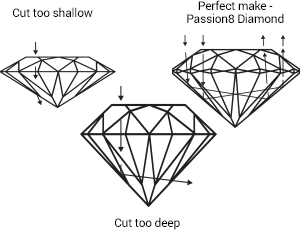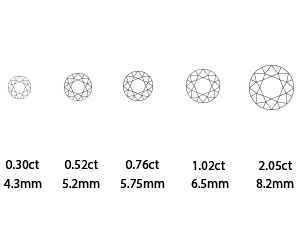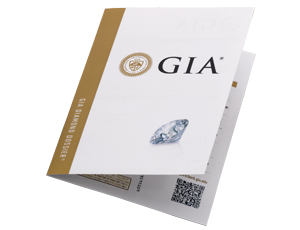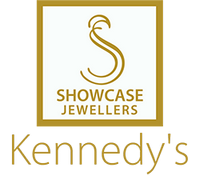Diamond Buying Guide
So, You Are Getting Engaged?
When buying a diamond it is important to do your research before making that commitment (in more ways than one)! To make your journey enjoyable and hassle free Showcase Jewellers would like to offer free, friendly consultations to assist you in the decision making process. At the same time we strongly encourage consumers to do their own research and gain an understanding on what it is they are after. We have prepared this guide to shed some light on an area which often leaves couples confused and unsure what they want in their engagement ring. We hope you find it useful in guiding you to your perfect gem!
To determine a diamond’s quality and worth you begin with the 4 Cs: Cut, Clarity, Colour and Carat weight. These are the traditional units of measure when looking at this precious stone, however, you must add one more imperative ‘C’ to the list and that is Confidence!
Clarity
This relates to the marks of non-crystallised carbon called ‘inclusions’ found within the diamond. The inclusions vary in standards on the spectrum ranging from FL (flawless), SI1 () to I3. It is exceedingly rare for a diamond to be flawless, known as FL and is the highest level on the spectrum. SI1 is in the middle of the spectrum and it is recommended when buying a diamond, you should not purchase lower than this standard. I3 is the lowest as it includes the mot inclusions and is least clear.


Cut
The cut of a stone is not relating to the shape, but refers to the way the cutter has formed it to best ensure that light bounces within the stone and back out through the top. If it has a defective cut (too long or too short) the light refracts on the inside and falls out down the bottom. This decreases the brightness and lustre of the stone. A well cut stone is neither exceedingly long nor shallow, it is luminous and will always dazzle even when dirty.The grading system varies from Ideal Cut to Good and lastly, Poor Cut. With round diamonds, it is suggested to never purchase below ‘Very Good’ and ‘Good’ in all other shapes. Again, the better cut stone the more it will cost.
Colour
Diamonds come in every colour, however, coloured stones are less desired as it diminishes the light's ability to dazzle as it does in colourless diamonds despite the cut. Unless, they are ‘Fancies’ which are rare diamond so unusually strong colour. The grade used to determine the desirability of colour in a diamond is measured from D (colourless) to Z (coloured yellow). The clear diamonds are the most prized and are the most expensive. It is recommended while purchasing a diamond you do not choose one less than grade H.


Carat Weight
The method of measuring the carat of a diamond is by weight. One carat is 0.2 grams and can be further divided into 100 points which is used to determine the lower carat stones. For instance, a stone with 25 points is 0.25 carats. For a more visual indication of what this means, is the smaller the stone the lower in carat weight and the larger the stone, the higher the carat and price.
Certificate
Ensure that you receive a certificate when buying diamonds. There are a few highly reputable grading houses around the world and they include GIA, AGS and DCLA. Never accept the certificate of the retailer, even if they are GIA certified. Only accept certificates from the above mentioned graders as they maintain high standards and ensure that the quality of the stone is exactly what you have paid for. Other labs are pressured to lower their standards, therefore you will be paying for a lower quality stone for a higher price.

